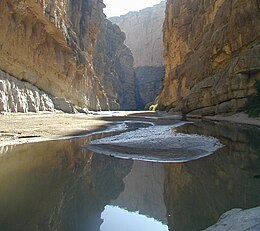Big Bend National Park
| Big Bend | |
| National Park | |
|
The Rio Grande, separating Mexico and the United States, within the walls of Santa Elena Canyon.
|
|
| Country | United States |
|---|---|
| State | Texas |
| Region | Chihuahuan Desert |
| City | Alpine (nearest) |
| River | Rio Grande |
| Location | Brewster County, Texas |
| - coordinates | 29°15′0″N 103°15′0″W / 29.25000°N 103.25000°WCoordinates: 29°15′0″N 103°15′0″W / 29.25000°N 103.25000°W |
| Highest point | |
| - location | Emory Peak, Chisos Mountains |
| - elevation | 7,832 ft (2,387 m) |
| Lowest point | |
| - location | Rio Grande |
| - elevation | 1,800 ft (549 m) |
| Area | 801,163 acres (324,219 ha) |
| Founded | June 12, 1944 |
| Management | National Park Service |
| Visitation | 381,747 (2015) |
| IUCN category | II - National Park |
| Website: Big Bend National Park | |
Big Bend National Park in Texas has national significance as the largest protected area of Chihuahuan Desert topography and ecology in the United States. It contains more than 1,200 species of plants, more than 450 species of birds, 56 species of reptiles, and 75 species of mammals.
The national park covers 801,163 acres (324,219 ha). A variety of Cretaceous and Cenozoic fossil organisms exist in abundance, and the park has artifacts estimated to be 9000 years old. Historic buildings and landscapes offer graphic illustration of life along the international border in the 19th century.
For more than 1,000 miles (1,600 km), the Rio Grande/Río Bravo forms the boundary between Mexico and the United States, and Big Bend National Park administers approximately 118 miles (190 km) along that boundary. The park was named after the area, which is bounded by a large bend in the river, and Texas–Mexico border (see map at right below).
Because the Rio Grande serves as an international boundary, the park faces unusual constraints while administering and enforcing park rules, regulations, and policies. In accordance with the Treaty of Guadalupe Hidalgo, the park's territory extends only to the center of the deepest river channel as the river flowed in 1848. The rest of the land south of that channel, and the river, lies within Mexican territory. The park is bordered by the protected areas of Parque Nacional Cañon de Santa Elena and Maderas del Carmen in Mexico.
The park exhibits dramatic contrasts and its climate may be characterized as one of extremes. Dry and hot late spring and summer days often exceed 100 °F (38 °C) in the lower elevations. Winters are normally mild but subfreezing temperatures occasionally occur. Because of the range in altitude from about 1,800 feet (550 m) along the river to Emory Peak in the Chisos Mountains at 7,832 feet (2,387 m), a wide variation in available moisture and temperature exists throughout the park. These variations contribute to an exceptional diversity in plant and animal habitats. Some species in the park, such as the Chisos oak (Quercus gravesii), are found nowhere else in the United States.
...
Wikipedia





